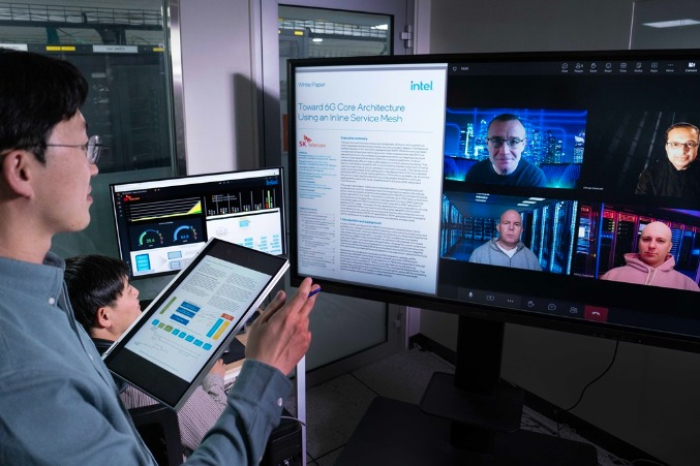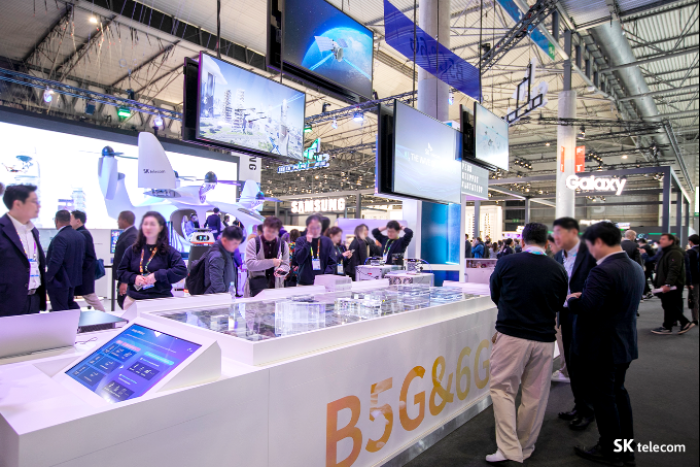Tech, Media & Telecom
SK Telecom brings forward 6G era with low-latency tech
Inline service mesh jointly developed with Intel lowers control plane transaction latency by 70% and CPU use by 33%
By Feb 01, 2024 (Gmt+09:00)
2
Min read
Most Read
LG Chem to sell water filter business to Glenwood PE for $692 million


KT&G eyes overseas M&A after rejecting activist fund's offer


Kyobo Life poised to buy Japan’s SBI Group-owned savings bank


StockX in merger talks with Naver’s online reseller Kream


Meritz backs half of ex-manager’s $210 mn hedge fund



South Korea’s information and communications technology (ICT) major SK Telecom Co. has developed a new technology jointly with US tech giant Intel Corp. that is expected to bring forward the 6G network era, the company announced on Thursday.
Tests conducted by SK Telecom and Intel showed that the so-called inline service mesh technology reduced latency overhead in data transactions by 70% and gateway central processing unit (CPU) use by 33% on 6G core architecture, SK Telecom said.
The new inline approach enables network communication between modules without proxies, resulting in faster core network traffic processing and higher efficiency in processing massive volumes of data, according to a White Paper titled “Toward 6G architecture using an inline service mesh,” published on Jan. 24, 2024.
SK Telecom and Intel expect such a low-latency service mesh to usher in the 6G era earlier than expected with further improvement.
AI-POWERED 6G CORE ARCHITECTURE
The low-latency service is expected to significantly enhance network traffic processing on bare metal-based cloud native 6G core architecture, highly touted as the next-generation wireless network that can be powered by AI.
A core network is a gateway between end users and the internet network, designed to enable network traffic at high speeds.
Bare metal cloud native refers to an advanced technology developed to lighten the system so that the operating system is not duplicated between hardware resources and virtual resources in the cloud.
Bare metal cloud native architecture allows cloud native applications to be deployed in containers running directly on the bare metal cloud, which radically simplifies network implementation.
As the core network advances, the wireless network becomes increasingly complex, delaying communication in the network.
But SK Telecom and Intel expect the newly discovered inline service mesh technology to address such a slow traffic processing issue.
As 6G standards and specifications are still under development, SK Telecom and Intel will seek to apply with 3GPP to register their new technology as a 6G specification after review, the Korean company said.
3GPP is an international organization that develops technical specifications and technical reports for cellular telecommunications technologies.

SK Telecom and Intel have been carrying out various research projects to develop critical wireless communication technologies for a decade.
The latest development is part of their joint research to improve network traffic processing on an advanced AI-embedded core network and cloud.
SK Telecom’s crosstown rivals KT Corp. and LG Uplus Corp. are also in a race to develop 6G network technologies. They are focused on the development of an open LAN ecosystem, the foundation of the 6G network.
The Korean telco trio’s 6G efforts are expected to gain speed as the Korean government has also designated the 6G wireless network, considered the underlying technology for generative AI, as one of the key technologies the nation must obtain and take leadership, according to a plan unveiled by Korea’s Ministry of Science and ICT on Wednesday.
Write to Seung-Woo Lee at leeswoo@hankyung.com
Sookyung Seo edited this article.
More to Read
-
 Tech, Media & TelecomKorea’s 6G frequency bands picked as standard candidates
Tech, Media & TelecomKorea’s 6G frequency bands picked as standard candidatesDec 18, 2023 (Gmt+09:00)
2 Min read -
 Tech, Media & TelecomSK Telecom develops reconfigurable surface tech for 6G transmission
Tech, Media & TelecomSK Telecom develops reconfigurable surface tech for 6G transmissionFeb 09, 2023 (Gmt+09:00)
1 Min read
Comment 0
LOG IN


